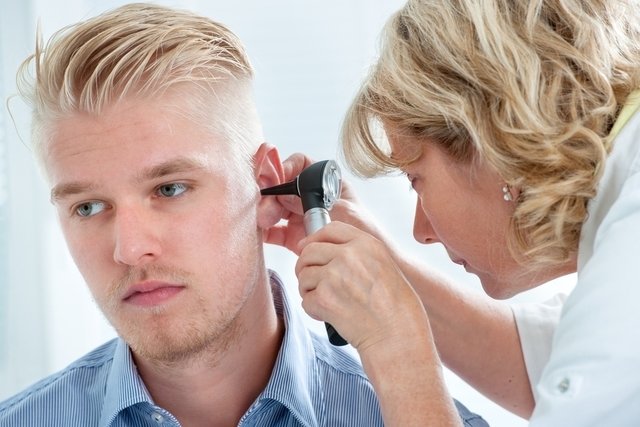Ear discharge usually occurs due to an infection in the inner or outer ear, but it can also occur due to injuries to the head or eardrum, which usually occur due to blows and accidents, or when objects are inserted into the ear canal.
The appearance of ear secretion, also known as otorrhea, depends on the cause, but it is normally transparent, yellowish or whitish in color, accompanied by a bad smell, when caused by bacteria, or reddish, when caused by injury.
In any case, it is always advisable to consult an ENT, who may recommend the use of analgesics, anti-inflammatories or antibiotics.

Below we indicate the main causes for the appearance of discharge in the ear:
1. Otitis media
Otitis media or interna is an inflammation caused by viruses or bacteria, or in rarer cases, by fungi, trauma or allergies, which can give rise to an infection, with signs and symptoms such as ear pain, release of yellow secretion or whitish with bad odor, hearing loss and fever. Learn more about otitis media.
Otitis is more common in babies and children, and in these cases, it can be more difficult to identify the symptoms. Therefore, if the baby has a fever, is irritable, or frequently touches his ear, it could be a sign of otitis, and it is important to consult a pediatrician.
How to deal with: treatment consists of administering analgesic and anti-inflammatory medications such as dipyrone and ibuprofen, in order to alleviate symptoms. If it is a bacterial infection, the doctor may recommend the use of antibiotics such as amoxicillin, for example. See the main remedies for inflamed ears.
Don’t ignore the signs your body is giving you!
2. Foreign bodies
Foreign objects can become lodged inside the ear accidentally or intentionally, in the case of children. Normally, objects that get stuck in the ears can be small toys, buttons, insects or food, which can cause pain, itching and the release of secretion in the ear.
How to deal with: treatment consists of removing the foreign body by a healthcare professional, who may use a suction machine. In more serious cases, surgery may be necessary.
3. Otitis externa
Otitis externa is an infection of a region of the ear canal, which is located between the outside of the ear and the eardrum, causing symptoms such as pain and itching in the area, fever and the release of a whitish or yellowish secretion with a bad smell. The most common causes may be exposure to heat and humidity, or the use of cotton swabs, which facilitate the proliferation of bacteria in the ear. See other causes and characteristic symptoms of otitis externa.
How to deal with: the treatment of otitis externa consists of cleaning the ear canal with saline or alcoholic solutions, and applying topical remedies for infection and inflammation, and antibiotics such as neomycin, polymyxin and ciprofloxacin, for example.
If the eardrum is perforated, other medications may be necessary. As otitis can cause pain and inflammation, the ENT specialist may also advise taking painkillers, such as dipyrone or paracetamol, or anti-inflammatories, such as ibuprofen.
4. Mastoiditis
Mastoiditis consists of an inflammation of a bone located behind the ear, the mastoid bone, and can occur due to a complication of poorly treated otitis media, when bacteria spread from the ear to this bone. This inflammation causes symptoms such as redness, swelling and pain around the ear, as well as fever and yellowish discharge. In more serious cases, an abscess may form or destruction of the bone may occur.
How to deal with: Generally, treatment involves the use of intravenous antibiotics, such as ceftriaxone and vancomycin, for 2 weeks. In more serious situations, if an abscess forms or if there is no improvement with the use of antibiotics, it may be necessary to drain the secretion through a procedure called myringotomy, or even opening the mastoid.
5. Head injury
Serious head injuries, such as a shock or a skull fracture, can also cause ear secretions, usually blood.
How to deal with: These types of head injuries are medical emergencies, so if they occur, you should see a doctor urgently.
6. Perforation of the eardrum
Perforation of the eardrum, which is a thin film that separates the inner ear from the outer ear, can cause pain and itching in the ear, decreased hearing, or even bleeding and the release of other secretions through the ear canal. The signs and symptoms that may occur during a perforation of the eardrum are itching and intense ear pain, tinnitus, dizziness, vertigo and otorrhea, in this case the yellowish secretion. Learn more about otorrhea.
How to deal with: normally a small perforation heals on its own in a few weeks to 2 months, and during this period it is advisable to cover your ear before taking a shower, and avoid going to the beach or swimming pool.
In some cases, especially if the perforation is large, antibiotics may be prescribed, such as a combination of amoxicillin and clavulanic acid. In more serious cases, surgery may be necessary. See what treatment for a perforated eardrum should be like.
7. Cholesteatoma
Cholesteatoma consists of a non-cancerous growth of skin in the middle ear, behind the eardrum, which is usually caused by repeated ear infections, but may, however, be a birth change.
Initially, a foul-smelling fluid may be released, but later, if it continues to grow, pressure may be felt in the ear, causing some discomfort, which can lead to more serious problems, such as the destruction of the bones in the middle ear, affecting hearing, balance and the functioning of facial muscles.
How to deal with: The only way to treat this problem is through surgery, in order to prevent more serious complications. After that, the ear should be evaluated to see if the cholesteatoma appears again.

Sign up for our newsletter and stay up to date with exclusive news
that can transform your routine!
Warning: Undefined array key "title" in /home/storelat/public_html/wp-content/plugins/link-whisper-premium/templates/frontend/related-posts.php on line 12
Warning: Undefined array key "title_tag" in /home/storelat/public_html/wp-content/plugins/link-whisper-premium/templates/frontend/related-posts.php on line 13



